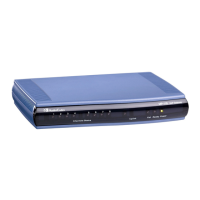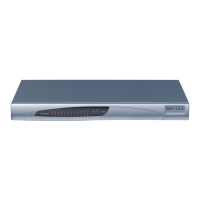IsEnable = Enables [1] or disables [0] (default) Japan NTT Modem
DID support.
For example:
EnableDID 0 = 1; (DID is enabled on Port 1)
Note: This parameter is applicable only to FXS interfaces.
[WinkTime]
Defines the time (in msec) elapsed between two consecutive polarity
reversals. This parameter can be used for DID signaling.
The valid range is 0 to 4,294,967,295. The default is 200.
Notes:
This parameter is applicable to FXS and FXO interfaces.
For this parameter to take effect, a device reset is required.
43.10.6 Answer and Disconnect Supervision Parameters
The answer and disconnect supervision parameters are described in the table below.
Table 43-50: Answer and Disconnect Parameters
Parameter Description
Web: Answer Supervision
EMS: Enable Voice Detection
[EnableVoiceDetection]
Enables the sending of SIP 200 OK upon detection of
speech, fax, or modem.
[1] Yes = The device sends a SIP 200 OK (in response
to an INVITE message) when speech, fax, or modem is
detected.
[0] No = (Default) The device sends a SIP 200 OK only
after it completes dialing.
Typically, this feature is used only when early media
(enabled using the EnableEarlyMedia parameter) is used
to establish the voice path before the call is answered.
Note: This feature is applicable only to one-stage dialing
(FXO).
Web/EMS: Max Call Duration (min)
[MaxCallDuration]
Defines the maximum duration (in minutes) of a call. If this
duration is reached, the device terminates the call. This
feature is useful for ensuring available resources for new
calls, by ensuring calls are properly terminated.
The valid range is 0 to 35,791. The default is 0 (i.e., no
limitation).
Web/EMS: Disconnect on Dial Tone
[DisconnectOnDialTone]
Determines whether the device disconnects a call when a
dial tone is detected from the PBX.
[0] Disable = (Default) Call is not released.
[1]

